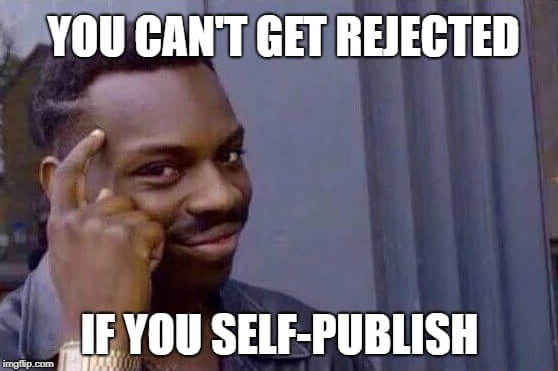
This self-publishing guide is designed for people who have never published anything before.
There are unlimited things you can do to help your book succeed, but the sheer volume of options are so daunting that many people are afraid to even begin.
Let’s focus on the essentials and just get your work out there. You can worry about getting fancy later.
Optional reading for fancy folk: 6 Things to do before you publish your book.
Step one: Write what people want to read

You aren’t a special snowflake. Nobody cares about you. Not yet anyway.
People don’t learn to play music by writing original compositions. They play songs that have already been played, on the same instruments that millions of other people play, reading sheet music someone else wrote. Learn the fundamentals, master them, and only then begin variations that make your work distinct.
Pick a pre-existing genre that you enjoy. Pick a modern bestseller that has been published in the last few years. Read it and take notes.
- Was the language florid or simple?
- Was it mostly dialogue? Or action? Or descriptive prose? How much of each?
- How were the characters introduced? How did they talk?
- What types of relationships exist between the characters, and how did they drive the plot forward?
Ask yourself as many questions as you can until you have a good summary of the book. Now write your own, following the same guidelines as closely as you can.
That doesn’t mean you’re going to write about Harry Painter and his Wizard school in France.
You aren’t ripping off the end result of the book. You’re ripping off the author’s thought process which led to that result.
For example: both Star Wars and Lord of the Rings (and many others) begin when a mentor figure (Gandalf or Obi-Wan) whisk their protege off on and adventure. Infinite variations of this concept can make infinite new stories that don’t copy each other. (Explained by Joseph Campbell’s Hero’s Journey).
Step Two: Interior Design

- Download a 5×8 pre-formatted Interior template
(I like the small trim size, but any 6×9 or smaller are fine). - Copy/Paste your manuscript into the body section.
- Customize headers, title page, make sure everything looks clean.
- Include a hyperlink at the back to one of your social media pages or email signups as well as a reminder to review the book.
- Save one file as a PDF to be used for the paperback. Save another file as .docx which can be uploaded directly into your eBook.
Step Three: Editing and Cover Design

You can probably find a freelance editor on upwork for around $500 for a 60-100k word manuscript, but you shouldn’t expect to make your money back from it. Don’t keep dumping money into your first book and pretend its an investment that will make you rich. Right now you’re just practicing and learning, and the less you set yourself back while doing this, the easier it will be to publish again and do it better.
A good alternative to an editor is to simply copy the text into a text-to-speech program and edit while it reads your work back to you. You’ll catch most of the mistakes that way.
Hire a cover designer at Fiverr. $20-40 range for a decent design. Again, you aren’t trying to be too unique. Look at the other top books in your genre and take some notes. Use similar stock images.
Step Four: Publishing
4) Publish on Amazon’s KDP. Enroll in KDP select, making your book exclusive to Amazon. This will keep all your sales and reviews in one place to maximize your visibility and provide you with essential built-in marketing tools.
Everything is really simple and intuitive, although there are a few things to keep in mind.
- Book Subtitle: Include genre specific search keywords. Browse other titles in your genre for ideas, or type general keywords into the amazon search bar and let the suggestions give you ideas.
- Keywords: Use 3-5 word phrases that people might search for. You can also use the suggestions in the amazon search bar for ideas.
- Book Categories: Ignore these for now, because only generic ones are immediately visible. Once the book is published, contact KDP and ask them to add you to up to 10 niche categories. You can find these categories by clicking through various books in your genre and making a list of relevant genres that they’re listed under. Pick categories where the the the #20 ranked book is ranked #20,000 or higher in the overall amazon store. The worse your book is ranked, the less competitive categories you want to be in.
- Book Description: Think of this as a hook almost like the beginning of a story. You’re poising a mystery that the reader needs to buy the book to find out. Identify the main conflict and stakes. Also include more genre/search keywords and phrases that you’re able to fit in without it sounding forced. A short excerpt highlighting an especially visual/graphic scene in the book or positive review can also be effective.
Step Five: Marketing

Book marketing isn’t about long-term sales. It’s not a never-ending process. And it’s not the source of most of your sales.
Book marketing is all about concentrating external sales into a short space of time. This will spike your book ranking which makes your book more visible on Amazon. If the book looks interesting, then people will start buying it and the ranking will stay high after the marketing efforts have ended. If the book is not interesting, then no amount of marketing is going to save it.
The two main stages of marketing are:
A) Get reviews for your book.
- Give free copies of your book to everyone you know.
- Build your mailing list by giving out more free copies to everyone who signs up.
- Remind everyone to leave an honest review.
- Try to get at least 10 reviews before you do any marketing.
B) Schedule free promotion days or .99 cent days in your KDP Dashboard.
- I find 3 consecutive days works best.
- Submit your book to as many websites as you can which feature free or discounted books.
- Promote your free book on reddit and social media during the actual free days.
If you want to run other ads and promotions, stack them all for the days immediately following your free promotion or during your discounted promotion when your rank will be highest.
Most of the work is really just learning how to do it. Your next book will be much easier.
Don’t obsess over your first book. This is just training.
Now do it again. Invest what you make into your next book. Use your growing mailing list for stronger launches. Keep writing, keep improving, keep refining your steps. You’re going to get out of this as much as you put into it.


